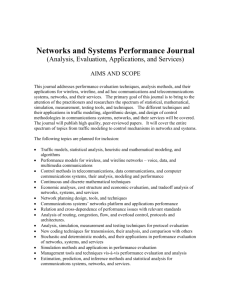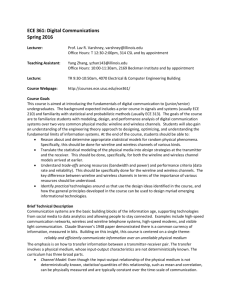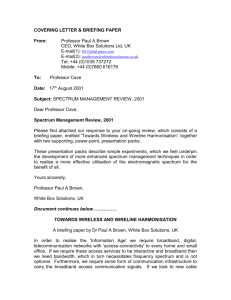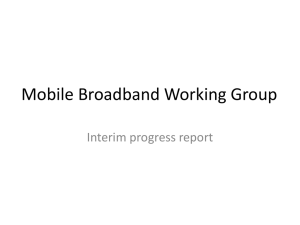Ericsson SAPC: Convergent Policy Control for Networks
advertisement
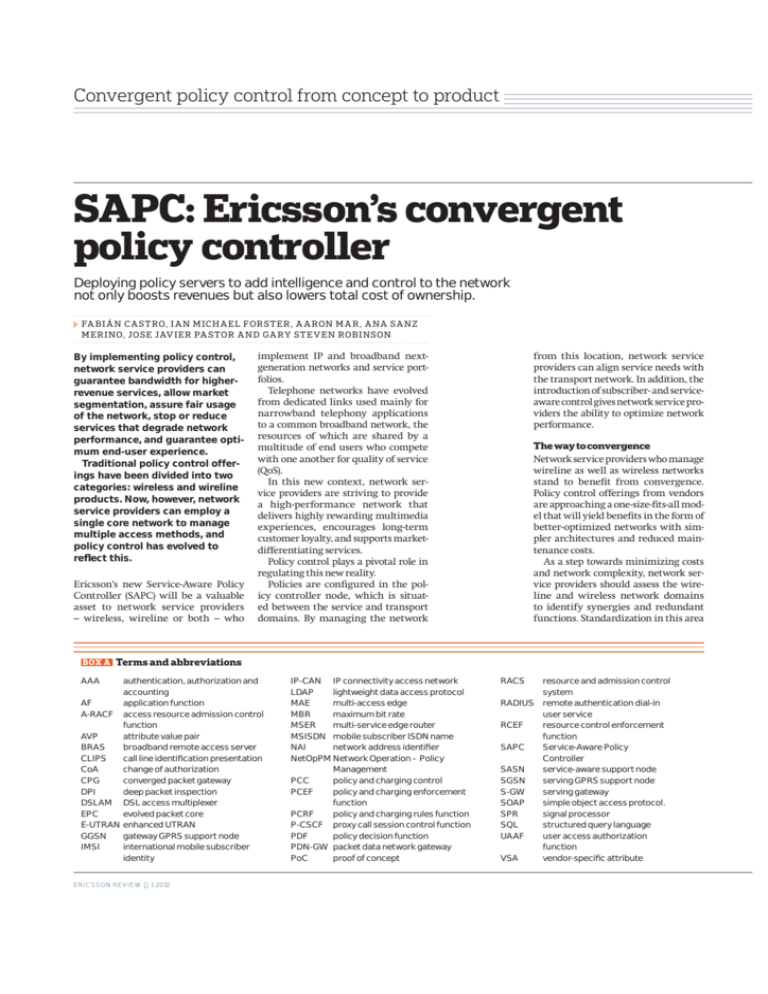
Convergent policy control from concept to product SAPC: Ericsson’s convergent policy controller Deploying policy servers to add intelligence and control to the network not only boosts revenues but also lowers total cost of ownership. FA BI Á N C A S T RO, I A N M IC H A E L F OR S T E R , A A RON M A R , A NA S A N Z M E R I NO, JO S E JAV I E R PA S T OR A N D GA RY S T E V E N ROBI N S ON By implementing policy control, network service providers can guarantee bandwidth for higherrevenue services, allow market segmentation, assure fair usage of the network, stop or reduce services that degrade network performance, and guarantee optimum end-user experience. Traditional policy control offerings have been divided into two categories: wireless and wireline products. Now, however, network service providers can employ a single core network to manage multiple access methods, and policy control has evolved to reflect this. Ericsson’s new Service-Aware Policy Controller (SAPC) will be a valuable asset to network service providers – wireless, wireline or both – who BOX A implement IP and broadband nextgeneration networks and service portfolios. Telephone networks have evolved from dedicated links used mainly for narrowband telephony applications to a common broadband network, the resources of which are shared by a multitude of end users who compete with one another for quality of service (QoS). In this new context, network service providers are striving to provide a high-performance network that delivers highly rewarding multimedia experiences, encourages long-term customer loyalty, and supports marketdifferentiating services. Policy control plays a pivotal role in regulating this new reality. Policies are configured in the policy controller node, which is situated between the service and transport domains. By managing the network from this location, network service providers can align service needs with the transport network. In addition, the introduction of subscriber- and serviceaware control gives network service providers the ability to optimize network performance. The way to convergence Network service providers who manage wireline as well as wireless networks stand to benefit from convergence. Policy control offerings from vendors are approaching a one-size-fits-all model that will yield benefits in the form of better-optimized networks with simpler architectures and reduced maintenance costs. As a step towards minimizing costs and network complexity, network service providers should assess the wireline and wireless network domains to identify synergies and redundant functions. Standardization in this area Terms and abbreviations AAA authentication, authorization and accounting AF application function A-RACF access resource admission control function AVP attribute value pair BRAS broadband remote access server CLIPS call line identification presentation CoA change of authorization CPG converged packet gateway DPI deep packet inspection DSLAM DSL access multiplexer EPC evolved packet core E-UTRAN enhanced UTRAN GGSN gateway GPRS support node IMSI international mobile subscriber identity E R I C S S O N R E V I E W • 1 2010 IP-CAN IP connectivity access network LDAP lightweight data access protocol MAE multi-access edge MBR maximum bit rate MSER multi-service edge router MSISDN mobile subscriber ISDN name NAI network address identifier NetOpPM Network Operation – Policy Management PCC policy and charging control PCEF policy and charging enforcement function PCRF policy and charging rules function P-CSCF proxy call session control function PDF policy decision function PDN-GW packet data network gateway PoC proof of concept RACS resource and admission control system RADIUS remote authentication dial-in user service RCEF resource control enforcement function SAPC Service-Aware Policy Controller SASN service-aware support node SGSN serving GPRS support node S-GW serving gateway SOAP simple object access protocol. SPR signal processor SQL structured query language UAAF user access authorization function VSA vendor-specific attribute has led to the approach defined by the 3rd Generation Partnership Project (3GPP), which employs a single core network to manage multiple access methods. Where policy control is concerned, network service providers can configure a single “box” to apply common policies to the wireline and wireless domains. This allows for seamless enduser movement from the wireline network to the wireless network (or vice versa), and sets the stage for true multiaccess networks. Convergence also provides a strong value proposition, by reducing total cost of ownership (TCO) and introducing new revenue streams via a futureproof investment. Reduced TCO TCO is reduced by lowering capital expenditures (CAPEX) and operating expenses (OPEX). With converged policy control, network service providers can use common functions and processes to control multiple access methods. Having shared or common hardware means there are fewer “boxes” in the network, and represents a step toward making the converged policy controller the primary node for centralized administration and control. Likewise, having a unique subscription profile helps to maximize operations efficiency. New revenue streams Being able to control a network with wireline and wireless services from a single point opens the door to new business opportunities. One immediate benefit is enhanced user experience: when subscribers move between network access types – digital subscriber line (DSL) and high-speed packet access (HSPA), for example – the network behaves in the same way in terms of QoS, services allowed and so forth. Other benefits of convergence include bandwidth management with convergent deep packet inspection (DPI), and common quota management with redirection to a top-up portal. Future-proof investment Consolidation and network simplification are logical progressions with regard to managing multiple types of access. Furthermore, they are in step with FIGURE 1 Converged policy control for network service providers offering wireless and wireline access. AF SAPC MSISDN NAI (PPP/CLIPS) S-GW/ SGSN MAE MSER other developments relative to service provider networks and services. Market view and vision The market for policy control is very active, especially for wireless access following the introduction of mobile broadband. Today, with advanced new mobile terminals and good tariff plans, end users are increasingly likely to use their mobile devices to access the new services via the Internet. But since radio network capacity is a finite resource, limitations of some kind need to be enforced. By applying fair-usage policies, network service providers can minimize end-user abuse by the 10 percent of subscribers who consume 90 percent of network resources. Throttling, which limits throughput, controls capacity as data traffic increases. Other offerings include a variety of unlimited mobile broadband price plans, such as post-paid (flexible price plans), pre-paid (pay-as-you-go, or volume or time vouchers), and throttling buyout offers. These plans can be made more visible and attractive to end users, for example, via notifications or redirections to a web portal. The inclusion of a policy server in the network can significantly increase revenues for network service providers, and analysts anticipate a strong market for policy control solutions. Ericsson’s work in the field of policy control is fully aligned with current standardization efforts. 3GPP Release 8 (Rel-8), for instance, is a system that supports multiple kinds of access. In the system architecture, the core network hosts the anchor point (a packet data network gateway or PDN-GW) for these access types. A network edge element (the multi-access edge or MAE) provides connectivity to the internet, in addition to supporting a diverse set of services. However, 3GPP Rel-8 is only the initial step toward achieving a complete multiaccess network. It does not, for instance, specify how wireline access should be included. Ericsson’s position is that a policy controller, such as its SAPC, is needed to create a seamless central control point in the network. This approach provides all the required functionality coming from both wireless and wireline access (Figure 1). Proof-of-concept prototype The first step toward realizing a converged SAPC product is to create a proofof-concept prototype. Integrating software components of the Network Operation – Policy Management (NetOp PM) into the SAPC product, E R I C S S O N R E V I E W • 1 2010 Convergent policy control from concept to product FIGURE 2 Wireless access policy control. AF Rx Application layer SAPC (PCRF) Centralized policy control Transport level Gx MSISDN GGSN/SASN (PCEF) Ericsson’s prototype demonstrates the flexibility of SAPC to perform policy and charging control (PCC) across wireline and wireless access. The prototype is fully compliant with the 3GPP PCC architecture, implementing the policy and charging rules function (PCRF), and standard Gx and Rx interfaces. The Gx interface enables standardized integration between DPI and the PCRF. In 3GPP Release 7 (Rel-7), the Gq interface (TS 29.207) defined in 3GPP Release 6 (Rel-6) (between the proxy call session control function or P-CSCF and the policy decision function or PDF) was replaced by the updated Rx interface, which introduced the PCRF and encapsulated the PDF. Serving in the role of a PCRF, the SAPC provides PCC. The policy decisions FIGURE 3 it generates are communicated to the gateway, typically a gateway GPRS support node (GGSN), by means of PCC rules through the Gx interface. One of the policy controls defined in the 3GPP PCC architecture is QoS control (Figure 2). The policy and charging enforcement function (PCEF) – for instance, the GGSN or serviceaware support node (SASN) – enforces the authorized QoS for an internet protocol-connectivity access network (IP-CAN) bearer according to information received via the Gx interface, and the bearer establishment mode. In keeping with the architecture, the SAPC prototype also integrates new functionality for wireline access. Specifically, it implements a subset of the access resource admission con- Wireline access policy control. RADIUS RADIUS server SAPC (A-RACF) 2 SPR RADIUS messages are proxied toward the AAA nodes RADIUS 1 3 RADIUS CoA Centralized policy control Transport level PPP MSER (RCEF) E R I C S S O N R E V I E W • 1 2010 trol function (A-RACF) defined in the TISPAN standard (Figure 3). Serving in the role of an A-RACF, the SAPC provides resource reservation admission control and network policy control. The policy decisions it generates are communicated to the resource control enforcement function (RCEF) – typically a multi-service edge router (MSER) by means of remote authentication dial-in user service (RADIUS) attributes through a RADIUS changeof-authorization (CoA) interface. The MSER, which serves as a broadband remote access server (BRAS), sits at the edge of an ISP network, where it aggregates and controls user sessions from the access network. Examples of the control the SAPC applies to user sessions include QoS policy control and portal redirects. Control can be based on a variety of conditions, including subscription profile, time of day and usage. The prototype includes RADIUS accounting proxy functionality, which allows a converged node between a BRAS and a carrier’s authentication, authorization and accounting (AAA) node to support converngent usage control and policy control. With this network architecture, the SAPC can, when it receives an accounting start, stop, or interim message, detect when user sessions have been established, terminated or changed. Session establishment in the MSER triggers an evaluation process in the SAPC. The outcome of this evaluation is a set of policy control parameters to be applied to the session via a RADIUS CoA message. The SAPC component makes policy decisions for wireline and wireless accesses, providing a centralized control that is based on a single subscription. The SAPC maintains one subscription that associates different subscriber access identities (mobile subscriber ISDN name or MSISDN, international mobile subscriber identity or IMSI, and network address identifier or NAI) to a single subscription or administrative identity. Users are treated as part of an offering or group according to their subscription references. For example, they could be divided into Gold, Silver and Bronze groups for all the types of access they are granted. In the case of a Gold user, the SAPC would keep a Gold plan and tie Gold policies to all (enforcement) nodes through which the user’s traffic passes. These policies could authorize the same services and QoS in the wireline and wireless access types, or they could differentiate services and QoS based on the user’s access type (Figure 4). The SAPC also supports fair usage functionality by extracting wireline and wireless access information. Reports about wireless access usage are received through the Gx interface; wireline access usage is conveyed via RADIUS accounting messages. The SAPC collects the reported volume in a user accumulation counter that permits control of subscriber usage and allows for actions to be taken when subscribers exceed their usage limits. Examples of actions are restricting access, downgrading QoS, redirecting, declining sessions, and notifying the subscriber via text message or e-mail. The SAPC supports common accumulators for use with both wireline and wireless access. These accumulators can be configured to apply end-user limits to all types of access or different limits to different types of access (Figure 5). SAPC demonstration at Mobile World Congress Ericsson gave a live demonstration of the SAPC at the Mobile World Congress 2010 in Barcelona. The demonstration involved a subscriber able to access the network from both a wireless and a wireline access network. During the demonstration, the subscriber initiated concurrent wireline and wireless sessions. The SAPC first evaluated session and user subscription data. It then sent policy decisions to the enforcement points – for wireline access, the SmartEdge router; for wireless access, the GGSN and SASN. The first case demonstrated a user in the Gold group. This category of users is entitled to high QoS over both wireline and wireless accesses. During the course of the sessions, the user subscription was reassigned (through the GUI) to the Silver group. This change called for reauthorization in the SAPC, which then communicated a QoS downgrade to both accesses. The effect of the downgrade could be seen in the monitoring PCs. The second use case demonstrat- FIGURE 4 Converged policy control. SAPC Centralized policy control MSISDN NAI (PPP) FIGURE 5 Transport level GGSN/ SASN MSER Converged usage control. e-paid Converged pr ys 7 da MBR= 1 Mbps Limit= 1 GB SAPC Fair usage control Usage accumulator AVP: Granted quota VSA: Granted quota Centralized policy control Usage limit Actual usage Gx+ Quota RADIUS CoA Gx+ RADIUS Acc Metered services Usage reporting <Quota exhausted> MSISDN NAI (PPP/CLIPS) Usage reporting <Reporting interval for metered services> Transport level GGSN/ SASN MSER E R I C S S O N R E V I E W • 1 2010 Vinjett Convergent policy control from concept to product FIGURE 6 Demo infrastructure. Wireline terminal CPE Wireless terminal Wireline terminal GE 1/1 DSLAM SmartEdge RADIUS server SAPC GUI, LDAP browser RADIUS, RADIUS CoA Includes support for fixed SAPC session bring up and policy control using RADIUS Acc, RADIUS CoA Diameter for policy control (Gx + Rel-7) DIAMETER for policy control (Gx + Rel-6) Demo monitoring PCs SASN Radio access SGSN Packet core Operator service network Gi GGSN Internet FIGURE 7 Internal architecture and reference model. Node-B/eNB Wireless access L3–L7 PCEF L3–L7 PCEF GGSNCPG DPI-box (SASN) WCDMA, HSPA, LTE AF Operator services (wireless) Portals Rx, SOAP Gx(+) SAPC Non-3GPPP access SPR NetOp PM/ Ext-AAA AAA 2 1 AAA (UAAF) 5 3 ARACF SPR PCRF RADIUS Internet/ services 4 Policy eng Rg, SOAP Gx(+) RADIUS CoA DSLAM Fixed access L2–L7 PEF L3–L7 PCEF MSER DPI-box (SASN) ASE card E R I C S S O N R E V I E W • 1 2010 AF Operator services (wireline) Portals ed fair usage. The subscriber in this demonstration initiated concurrent wireline and wireless sessions. During the course of the sessions, the SASN and the gateway reported usage data to the SAPC. The user had a subscription to a wireline-wireless plan with a data usage limit of 10GB – wireline, wireless or both. After reaching this limit, the subscriber was redirected to a web portal where the quota could be topped up. The infrastructure for the live demonstration consisted of the following parts: A radio access network and a mobile packet core network where the SAPC received usage reports about wireless user sessions from a DPI node (SASN). The SAPC then sent policy decisions to the SASN and GGSN, where they were enforced. A fixed access network that comprised customer premises equipment (CPE) – in this case, end-user workstations and an asymmetric DSL or ADSL modem; a DSL access multiplexer (DSLAM), which collected traffic from multiple subscribers into a centralized point; a SmartEdge router, which served as a BRAS, routing traffic to and from the DSLAM; and a RADIUS server, to which the SAPC forwarded RADIUS requests received from the SmartEdge router. The SAPC, which served as the centralized policy decision point. PCs for monitoring usage and QoS of user sessions initiated from both access networks. An operation administration and maintenance (OAM) PC, which, via a lightweight data access protocol (LDAP) browser and graphical user interface (GUI), was used to provision and configure the SAPC. Proof of concept becomes product Given the success of the SAPC demonstration at the Mobile World Congress 2010, the next logical step is product commercialization. Apart from incorporating new functional features, emphasis is put on operations and aspects of management. The objective is to give network service providers an easy-to-configure product that contains tools for collecting statistics and detecting faults, and has the same look and feel for both wireless and wireline accesses. The result is a solid product with a “friendly” GUI that allows flexible configurations according to network service provider needs. In terms of architecture, the A-RACF, PCRF and AAA components share a powerful and flexible policy engine (Figure 7). The SAPC communicates with wireless and wireline access gateways using standard or de facto standard protocols. It also supports connection to the network application layer via standard protocols or using web service technology for easy integration with application functions that do not implement 3GPP or TISPAN protocols. Web service technology may also be used with operation and maintenance (O&M) systems that do not support LDAP. The SAPC can support external or internal databases to store subscriber data (LDAP), structured query language (SQL), and extensible markup language (XML). The converged approach gives added value. Examples include converged bandwidth control for wireless access, wireline access or both. This gives network service providers the tools to differentiate between user categories that can be defined across accesses; and converged fair usage control based on time, volume or both. This involves the ability to specify separate quotas per service or access type, or to define quotas common to both access types. Other features include support for redirection to a web portal using flexible policies (for instance, manual authentication of an unauthorized user) and for notifications informing subscribers of events, such as consumption of a volume quota. The functionality is key to give users information about their current options for extending the service when, say, a usage limit has been reached. The SAPC can also serve in deployments that include only one access (either wireless or wireline), taking advantage of the features mentioned above, as well as of other accessspecific features (by applying charging control or RAN congestion-avoidance mechanisms in wireless access types, for instance). Fabián Castro Ana Sanz Merino joined Ericsson in 2001 and has worked in system management on a wide range of products and solutions. For the past five years he has been involved in developing the specifications of the SAPC and is currently responsible for Fixed Mobile Convergence. In this role he helps define and coordinate the evolution of SAPC. Fabián holds an M.Sc. in computer systems engineering from the University of Oviedo, Spain. joined Ericsson in 2000 after receiving an M.Sc. in electrical engineering from the Polytechnic University of Madrid, Spain. She then obtained an M.Sc. in computer science from Berkeley, University of California. She received the Siebel Systems 2005 scholarship and the Fundación Telefónica award for the best final thesis in telecommunications networks and services in Spain. Ana currently works at the Ericsson R&D center in Madrid performing system engineering tasks in the area of policy control. Ian Michael Forster joined Ericsson in 2006 through the acquisition of Redback Networks. He has worked in a variety of areas including design, architecture and system management. During the past 10 years he has focused on network performance and management, policy control, and system management. Ian holds a B.Sc. in computer science from the University of Victoria, Canada. José Javier Pastor joined Ericsson in 1998 and has worked in a variety of areas including design, system management and standardization. He has devoted the past five years to 3GPP standards that drive policy control architecture. He is currently responsible for releases of SAPC. Javier holds an M.Sc. in telecommunications engineering from the University of Valladolid, Spain and an MBA. Gary Steven Robinson joined Ericsson in 2006 as part of the Redback Networks acquisition, serving as development manager for the NetOp Policy Manager, Redback’s highly successful wireline policy controller product. He has spent much of his career developing innovative solutions in customer care, policy control, and systems management. Gary holds a B.Sc. in interdisciplinary studies from Simon Fraser University in Burnaby, Canada. Aaron Mar joined Ericsson in 2006 when Redback Networks was acquired. He has worked in the telecom industry for over 15 years in the areas of design and architecture, and holds several patents in policy management and control. Aaron holds a Bachelor of Applied Science degree in electrical computer engineering from the University of British Columbia, Canada. References 1. 3GPP Rel-8 E-UTRAN/EPC (http://3gpp.org) 2. TISPAN Rel-2 RACS specifications (www.etsi.org/tispan) 3. Broadband Forum specifications (www.broadband-forum.org) 4. Infonetics “Policy Servers Biannual Worldwide and Regional Market Share, Size, and Forecasts” (www.infonetics.com) E R I C S S O N R E V I E W • 1 2010
